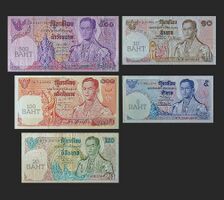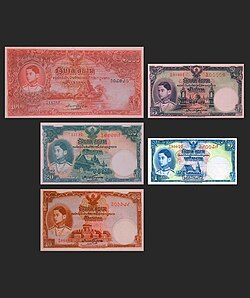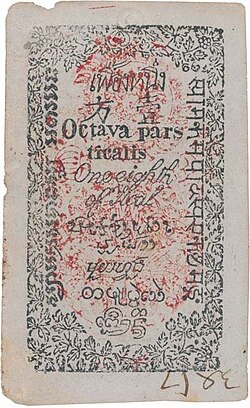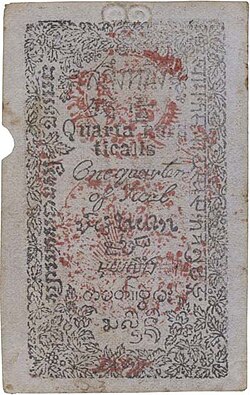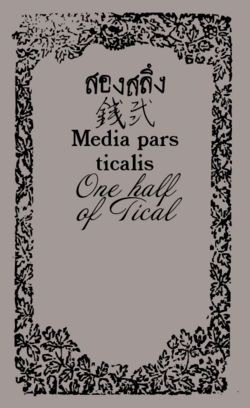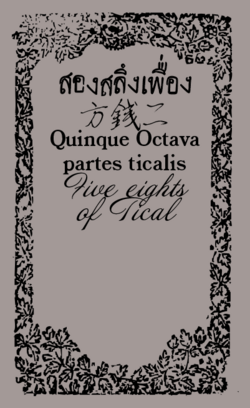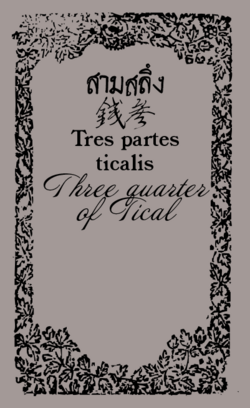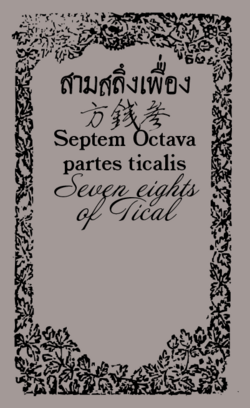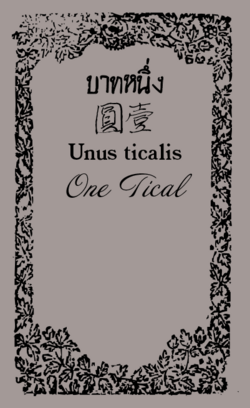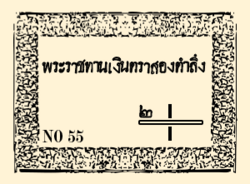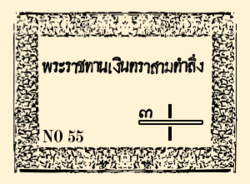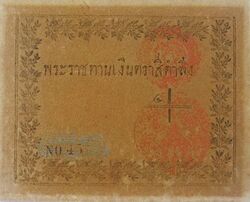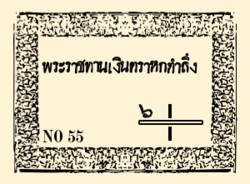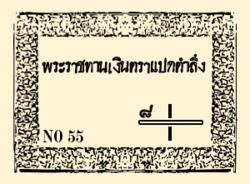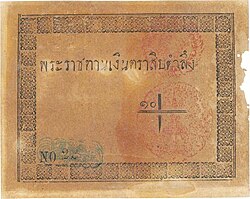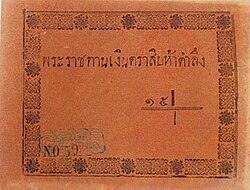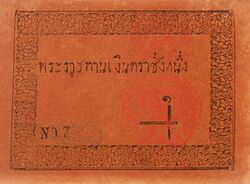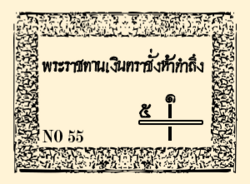Physics:Thai baht
| บาทไทย (Thai) | |
|---|---|
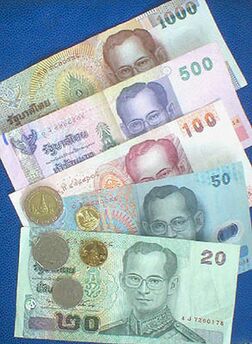 Baht banknotes and coins issued by the Bank of Thailand | |
| ISO 4217 | |
| Code | THB (numeric: 764) |
| Subunit | 0.01 |
| Unit | |
| Plural | The language(s) of this currency do(es) not have a morphological plural distinction. |
| Symbol | ฿ |
| Denominations | |
| Subunit | |
| 1⁄100 | satang |
| Banknotes | |
| Freq. used | ฿20, ฿50, ฿100, ฿500, ฿1000 |
| Coins | |
| Freq. used | 25, 50 satang, ฿1, ฿2, ฿5, ฿10 |
| Rarely used | 1, 5, 10 satang |
| Demographics | |
| Official user(s) | |
| Unofficial user(s) |
|
| Issuance | |
| Central bank | Bank of Thailand |
| Website | www |
| Printer | Note Printing Works of the Bank of Thailand |
| Mint | Royal Thai Mint |
| Website | www |
| Valuation | |
| Inflation | 1.0% |
| Source | Inflation (annual %), World Bank, 2011–2015 |
The baht (/bɑːt/; Thai: บาท, pronounced [bàːt]; sign: ฿; code: THB) is the official currency of Thailand. It can be divided into 100 satang (สตางค์, pronounced [sà.tāːŋ]). The issuance of currency is the responsibility of the Bank of Thailand. SWIFT ranked the Thai baht as the 10th-most-frequently used world payment currency as of December 2023.[1]
History
The Thai baht, like the pound, originated from a traditional unit of mass. Its currency value was originally expressed as that of silver of corresponding weight (now defined as 15 grams), and was in use probably as early as the Sukhothai period in the form of bullet coins known in Thai as phot duang.[2] These were pieces of solid silver cast to various weights corresponding to a traditional system of units related by simple fractions and multiples, one of which is the baht. These are listed in the following table:[3][4]
| Unit (RTGS) | Thai spelling | Relative value | Value relative to baht | Value relative to satang | Notes |
|---|---|---|---|---|---|
| Bia | เบี้ย | 1⁄100 at | 1⁄6400 | 0.015 | Bia is Thai for cowry, the shell of which was used as a trade medium of the same value. |
| Solot | โสฬส | 1⁄16 fueang | 1⁄128 | 0.78 | Solot here literally means sixteen or sixteenth, referring to the fractional amount relative to a fueang. |
| At | อัฐ | 1⁄8 fueang | 1⁄64 | 1.56 | Likewise, at literally means eight. |
| Siao/Phai | เสี้ยว/ไพ | 1⁄4 fueang | 1⁄32 | 3.125 | Siao means quarter. |
| Sik | ซีก | 1⁄2 fueang | 1⁄16 | 6.25 | Sik means half. |
| Fueang | เฟื้อง | 1⁄8 baht | 1⁄8 | 12.5 | The smallest silver bullet coins available in the market. |
| Salueng | สลึง | 1⁄4 baht (0.25 baht, 25 satang) | 1⁄4 | 25 | Thai version of the mace. It is also the equivalent of the Cambodian salong, and Burmese pya. |
| Song salueng | สองสลึง | 1⁄2 baht (0.50 baht, 50 satang) | 1⁄2 | 50 | |
| Baht | บาท | 1 | 100 | It is also the equivalent of the Cambodian baat, and Burmese kyat. It's alternative name is the tical. | |
| Tamlueng | ตำลึง | 4 baht | 4 | 400 | Thai version of the tael. |
| Chang | ชั่ง | 20 tamlueng | 80 | 8000 | Thai version of the catty. |
| Hab | หาบ | 80 chang | 6400 | 640000 |

That system was in use up until 1897, when the decimal system devised by Prince Jayanta Mongkol, in which one baht = 100 satang, was introduced by his half-brother King Chulalongkorn along with the demonetization of silver bullet coins on 28 October 1904 after the end of silver bullet coin production by the opening of Sitthikarn Royal Mint in 1857.[5] However, coins denominated in the old units were issued until 1910, and the amount of 25 satang is still commonly referred to as a salueng, as is the 25-satang coin.
Until 27 November 1902, the baht was fixed on a purely silver basis, with 15 grams of silver to the baht. This caused the value of the currency to vary relative to currencies on a gold standard. From 1856 to 1864, the values of certain foreign silver coins were fixed by law, with 5 baht = 3 Spanish dollar = 7 Indian rupees.[6] Before 1880 the exchange rate was fixed at 8 baht per pound sterling, falling to 10 to the pound during the 1880s.
In 1902, the government began to increase the value of the baht by following all increases in the value of silver against gold but not reducing it when the silver price fell. Beginning at 21.75 baht per pound sterling, the currency rose in value until, in 1908, a fixed peg to the British pound sterling was established of 13 baht per pound. This was revised to 12 baht in 1919 and then, after a period of instability, to 11 baht in 1923. During World War II, the baht was fixed at a value of one Japanese yen on 22 April 1942.[7][8]
From 1956 until 1973, the baht was pegged to the US dollar at an exchange rate of 20.8 baht = one dollar and at 20 baht = 1 dollar until 1978.[9] [10] A strengthening US economy caused Thailand to re-peg its currency at 25 to the dollar from 1984 until 2 July 1997, when the country was affected by the 1997 Asian financial crisis. The baht was floated and halved in value, reaching its lowest rate of 56 to the dollar in January 1998. It rose to 30 per dollar in January 2021.
The baht was originally known to foreigners by the term tical,[11] which was used in English language text on banknotes until the series 2 1925.[12][13]
Coins
Podduang Coinage
Cowrie shells from the Mekong River had been used as currency for small amounts since the Sukhothai period. Before 1860, Thailand did not produce coins using modern methods. Instead, a so-called "bullet" coinage was used, consisting of bars of metal, thicker in the middle, bent round to form a complete circle on which identifying marks were stamped.[14][15] Denominations issued included 1⁄128, 1⁄64, 1⁄32, 1⁄16, 1⁄8, 1⁄2, 1, 1 1⁄2, 2, 2 1⁄2, 4, 4 1⁄2, 8, 10, 20, 40 and 80 baht in silver and 1⁄32, 1⁄16, 1⁄8, 1⁄2, 1, 1 1⁄2, 2 and 4 baht in gold. One gold baht was generally worth 16 silver baht. Between 1858 and 1860, foreign trade coins were also stamped by the government for use in Thailand.
| Podduang of the Thai Tical (Rama III & Rama IV)[16] | |||||||||
|---|---|---|---|---|---|---|---|---|---|
| Image | Value | Width
(mm) |
Weight
(g) |
Composition | Inscription, Description | Date of Issue | |||
| Name | Secondary Name | Silver Baht Value | Gold Baht Value | ||||||

|
Bia
เบี้ย |
1⁄6400 | 1⁄102400 | 25 | 1.58 | Calcium Carbonate | None | 1238-1869 | |

|
Half Pai
กึ่งไพ |
Att
อัฐ |
1⁄64 | 1⁄1024 | 2 | 0.25 | Silver | State Ensign of Rattanakosin | 1824-1851 |

|
Pai
ไพ |
1⁄32 | 1⁄512 | 4 | 0.5 | Silver | State Ensign of Rattanakosin,
Castle |
1824-1856 | |

|
2 Pai
สองไพ |
Half Feuang
กึ่งเฟื้อง |
1⁄16 | 1⁄256 | 6 | 1 | Silver | State Ensign of Rattanakosin,
Castle |
1824-1856 |

|
Feuang
เฟื้อง |
1⁄8 | 1⁄128 | 6.5 | 1.98 | Silver | State Ensign of Rattanakosin,
Castle |
1824-1856 | |

|
Saleung
สลึง |
1⁄4 | 1⁄64 | 9 | 3.7 | Silver | State Ensign of Rattanakosin,
Castle |
1824-1856 | |

|
2 Saleung
สองสลึง |
Half Baht
กึ่งบาท |
1⁄2 | 1⁄32 | 11 | 7.6 | Silver | State Ensign of Rattanakosin,
Castle |
1824-1856 |

|
Baht
บาท |
1 | 1⁄16 | 14.5 | 15.14 | Silver | State Ensign of Rattanakosin,
Castle |
1824-1856 | |
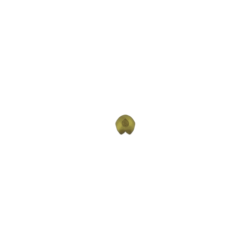
|
Gold Half Feuang
กึ่งเฟื้องทอง |
Gold 2 Pai
สองไพทอง |
1 | 1⁄16 | 5 | 1 | Gold | State Ensign of Rattanakosin | 1851-1856 |
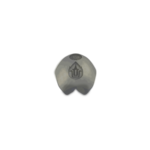
|
2 Baht
สองบาท |
Half Tamleung
กึ่งตำลึง |
2 | 1⁄8 | 17.5 | 30.30 | Silver | State Ensign of Rattanakosin,
Castle |
1824-1856 |

|
Gold Feuang
เฟื้องทอง |
2 | 1⁄8 | 6 | 1.5 | Gold | State Ensign of Rattanakosin | 1851-1856 | |

|
4 Baht
สี่บาท |
Tamleung
ตำลึง |
4 | 1⁄4 | 23.5 | 60.50 | Silver | State Ensign of Rattanakosin,
Castle |
1824-1856 |

|
Gold Saleung
สลึงทอง |
4 | 1⁄4 | 8 | 3.7 | Gold | State Ensign of Rattanakosin,
Phra Maha Mongkut Seal |
1851-1856 | |

|
Gold Half Baht
กึ่งบาททอง |
Gold 2 Saleung
สองสลึงทอง |
8 | 1⁄2 | 9.5 | 7.56 | Gold | State Ensign of Rattanakosin,
Phra Maha Mongkut Seal |
1851-1856 |

|
Gold Baht
บาททอง |
16 | 1 | 12 | 15.14 | Gold | State Ensign of Rattanakosin,
Phra Maha Mongkut Seal |
1851-1856 | |
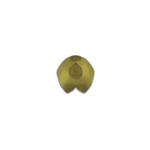
|
Gold Half Tamleung
กึ่งตำลึงทอง |
Gold 2 Baht
สองบาททอง |
32 | 2 | 16 | 30.01 | Gold | State Ensign of Rattanakosin,
Phra Maha Mongkut Seal |
1851-1856 |
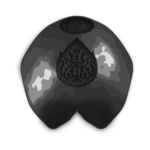
|
40 Baht
สี่สิบบาท |
Half Chang
กึ่งชั่ง |
40 | 2.5 | 48 | 606.5 | Silver | State Ensign of Rattanakosin,
Phra Maha Mongkut Seal |
1880 |

|
80 Baht
แปดสิบบาท |
Chang
ชั่ง |
80 | 5 | 59 | 1216 | Silver | State Ensign of Rattanakosin,
Phra Maha Mongkut Seal |
1859 |
Pre-decimal coinage
Rama III (1824–1851) was the first king to consider the use of a flat coin. He did so not for the convenience of traders, but because he was disturbed that the creatures living in the cowrie shells were killed. When he learned of the use of flat copper coins in Singapore in 1835, he contacted a Scottish trader, who had two types of experimental coins struck in England. The king rejected both designs. The name of the country put on these first coins was Muang Thai, not Siam.[17][18]
In 1860, modern style coins were introduced. These were silver 1 sik, 1 fuang, 1 and 2 salung, 1, 2 and 4 baht, with the baht weighing 15.244 grams and the others weight-related. Tin 1 solot and 1 att followed in 1862, with gold 2 1⁄2, 4 and 8 baht introduced in 1863 and copper 2 and 4 att in 1865. Copper replaced tin in the 1 solot and 1 att in 1874, with copper 4 att introduced in 1876. The last gold coins were struck in 1895.
| Coins of the Thai Tical (Rama IV & Rama V)[16] | |||||||||
|---|---|---|---|---|---|---|---|---|---|
| Image | Value | Dimensions
(mm) |
Weight
(g) |
Composition | Inscription, Description | Date of Issue | |||
| Obverse | Reverse | Name | Coinage Value | Obverse | Reverse | ||||
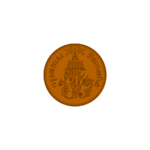
|
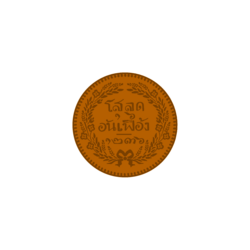
|
Solot
โสฬส |
1/16 Feuang,
1/128 Baht |
20 × 1 | 2.67 | Copper | Kingdom of Siam,
The Crowned Monogram of Rama V, Rama V |
Solot,
16 Parts Feuang, 1236 J.S. |
1875-1909 |
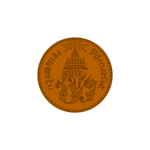
|

|
Att
อัฐ |
1/8 Feuang,
1/64 Baht |
25 × 1 | 5.58 | Copper | Kingdom of Siam,
The Crowned Monogram of Rama V, Rama V |
Att,
8 Parts Feuang, 1236 J.S. |
1875-1909 |

|

|
Siao
เสี้ยว |
1/4 Feuang,
1/32 Baht |
30.5 × 2 | 11.14 | Copper | Kingdom of Siam,
The Crowned Monogram of Rama V, Rama V |
Siao,
4 Parts Feuang, 1236 J.S. |
1875-1909 |

|
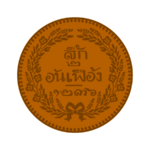
|
Sik
ซีก |
1/2 Feuang,
1/16 Baht |
38.5 × 2.5 | 22.57 | Copper | Kingdom of Siam,
The Crowned Monogram of Rama V, Rama V |
Sik,
2 Parts Feuang, 1236 J.S. |
1875-1909 |

|

|
Feuang
เฟื้อง |
1 Feuang,
1/8 Baht |
15 × 1 | 1.84 | Silver | Phra Maha Mongkut Seal with No Star | State Ensign of Siam with No Star | 1860-1909 |

|

|
Saleung
สลึง |
1/16 Tamleung,
1/4 Baht |
22 × 1 | 3.7 | Silver | Phra Maha Mongkut Seal with 2 Star | State Ensign of Siam with 2 Star | 1860-1909 |

|

|
Half Baht
ครึ่งบาท |
1/8 Tamleung,
1/2 Baht |
27 × 1 | 7.46 | Silver | Phra Maha Mongkut Seal with 4 Star | State Ensign of Siam with 4 Star | 1860-1909 |
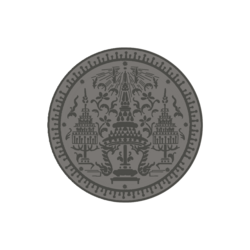
|
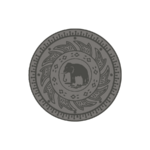
|
Baht
บาท |
1/4 Tamleung,
1 Baht |
31 × 1 | 15.45 | Silver | Phra Maha Mongkut Seal with 8 Star | State Ensign of Siam with 8 Star | 1860-1909 |
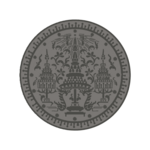
|
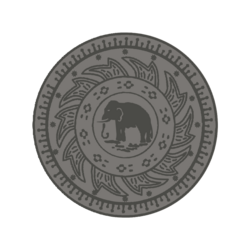
|
Half Tamleung
ครึ่งตำลึง |
1/2 Tamleung,
2 Baht |
37 × 2.5 | 30 | Silver | Phra Maha Mongkut Seal with 16 Star | State Ensign of Siam with 16 Star | 1860-1909 |

|

|
Pot Dueng
พัดดึงส์ |
5/8 Tamleung,
2.5 Baht |
16 × 0.8 | 1.83 | Gold | Phra Maha Mongkut Seal | State Ensign of Siam with No Star | 1863-1908 |

|

|
Pit
พิศ |
1 Tamleung,
4 Baht |
17 × 1 | 3.88 | Gold | Phra Maha Mongkut Seal | State Ensign of Siam | 1863-1908 |
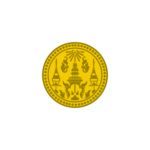
|

|
Tot
ทศ |
2 Tamleung,
8 Baht |
22 × 1 | 7.42 | Gold | Phra Maha Mongkut Seal | State Ensign of Siam | 1863-1908 |
Decimal coinage
In 1897, the first coins denominated in satang were introduced, cupronickel 2 1⁄2, 5, 10 and 20 satang. However, 1 solot, 1 and 2 att coins were struck until 1905 and 1 fuang coins were struck until 1910. In 1908, holed 1, 5 and 10 satang coins were introduced, with the 1 satang in bronze and the 5 and 10 satang in nickel. The 1 and 2 salung were replaced by 25 and 50 satang coins in 1915. In 1937, holed, bronze 1⁄2 satang were issued.
In 1941, a series of silver coins was introduced in denominations of 5, 10 and 20 satang, due to a shortage of nickel caused by World War II. The next year, tin coins were introduced for 1, 5 and 10 satang, followed by 20 satang in 1945 and 25 and 50 satang in 1946. In 1950, aluminium bronze 5, 10, 25 and 50 satang were introduced whilst, in 1957, bronze 5 and 10 satang were issued, along with 1-baht coins struck in an unusual alloy of copper, nickel, silver and zinc. Several Thai coins were issued for many years without changing the date. These include the tin 1942 1 satang and the 1950 5 and 10 satang, struck until 1973, the tin 1946 25 satang struck until 1964, the tin 50 satang struck until 1957, and the aluminium bronze 1957 5, 10, 25 and 50 satang struck until the 1970s. Cupronickel 1-baht coins were introduced in 1962 and struck without date change until 1982.
In 1972, cupronickel 5-baht coins were introduced, switching to cupronickel-clad copper in 1977. Between 1986 and 1988, a new coinage was introduced, consisting of aluminium 1, 5 and 10 satang, aluminium-bronze 25 and 50 satang, cupronickel 1 baht, cupronickel-clad-copper 5 baht and bimetallic 10 baht. Cupronickel-clad-steel 2 baht were introduced in 2005.
In 2008, the Ministry of Finance and the Royal Thai Mint announced the 2009 coin series, which included changes in materials to reduce production costs as well as an update of the image on the obverse to a more recent portrait of the king. The two-baht coin, confusingly similar in color and size to the one-baht coin, was changed from nickel-clad low-carbon steel to aluminium bronze. New two-baht coin was the first of the new series released on February 3, 2009, followed by the satang coins in April, a five-baht coin in May, a ten-baht coin in June, and a one-baht coin in July 2009.
In 2018, the Royal Thai Mint and the Ministry of Finance issued a new series of general circulation coins, featuring the same standard specifications, but feature a portrait of its current king, Maha Vajiralongkorn.
| Coins of the Thai baht (Rama IX) [2] [3] (in Thai) | |||||||||||||||||||||||||||||||||||||||||||||||||||||||||||||||||||||||||||||||||||||||||||||||
|---|---|---|---|---|---|---|---|---|---|---|---|---|---|---|---|---|---|---|---|---|---|---|---|---|---|---|---|---|---|---|---|---|---|---|---|---|---|---|---|---|---|---|---|---|---|---|---|---|---|---|---|---|---|---|---|---|---|---|---|---|---|---|---|---|---|---|---|---|---|---|---|---|---|---|---|---|---|---|---|---|---|---|---|---|---|---|---|---|---|---|---|---|---|---|---|
| Value | Technical parameters | Description | Date of first minting | ||||||||||||||||||||||||||||||||||||||||||||||||||||||||||||||||||||||||||||||||||||||||||||
| Diameter | Mass | Composition | Obverse | Reverse | 1 satang 1 | 15 mm | 0.5 g | 97.5% Al, 2.5% Mg | King Bhumibol Adulyadej | Wat Phra That Hariphunchai, Lamphun | 1987 | 99% Aluminium | 2008 | 5 satang 1 | 16 mm | 0.6 g | 97.5% Al, 2.5% Mg | Wat Phra Pathom Chedi, Nakhon Pathom | 1987 | 16.5 mm | 99% Aluminium | 2008 | 10 satang 1 | 17.5 mm | 0.8 g | 97.5% Al, 2.5% Mg | Wat Phra That Choeng Chum, Sakon Nakhon | 1987 | 99% Aluminium | 2008 | 25 satang | 16 mm | 1.9 g | Aluminium bronze | King Bhumibol Adulyadej | Wat Phra Mahathat, Nakhon Si Thammarat | 1987 | 16 mm | 1.9 g | Copper-plated steel | King Bhumibol Adulyadej | Wat Phra Mahathat, Nakhon Si Thammarat | 2008 | 50 satang | 18 mm | 2.4 g | Aluminium bronze | King Bhumibol Adulyadej | Wat Phra That Doi Suthep, Chiang Mai | 1987 | 18 mm | 2.4 g | Copper-plated steel | King Bhumibol Adulyadej | Wat Phra That Doi Suthep, Chiang Mai | 2008 | 1 baht | 20 mm | 3.4 g | Cupronickel (1986–2008) | King Bhumibol Adulyadej | Wat Phra Kaew, Bangkok | 1986 | 3 g | Nickel-plated steel (2008–present) | 2008 | 2 baht | 21.75 mm | 4.4 g | Nickel-plated low-carbon steel | King Bhumibol Adulyadej | Wat Saket, Bangkok | 2005 | 21.75 mm | 4 g | Aluminium bronze | King Bhumibol Adulyadej | Wat Saket, Bangkok | 2008 | 5 baht | 24 mm | 7.5 g | Copper nickel-clad copper | King Bhumibol Adulyadej | Wat Benchamabophit, Bangkok | 1988 | 6 g | 2008 | 10 baht | 26 mm | 8.5 g | Outer Ring: Copper-nickel Center Plug: Aluminium bronze |
King Bhumibol Adulyadej | Wat Arun, Bangkok | 1988 |
| 2008 | |||||||||||||||||||||||||||||||||||||||||||||||||||||||||||||||||||||||||||||||||||||||||||||||
| Coins of the Thai baht (Rama X) | |||||||||||||||||||||||||||||||||||||||||||||||||||||||||||
|---|---|---|---|---|---|---|---|---|---|---|---|---|---|---|---|---|---|---|---|---|---|---|---|---|---|---|---|---|---|---|---|---|---|---|---|---|---|---|---|---|---|---|---|---|---|---|---|---|---|---|---|---|---|---|---|---|---|---|---|
| Image | Value | Composition | Description | Date of minting | |||||||||||||||||||||||||||||||||||||||||||||||||||||||
| Obverse | Reverse | Obverse | Reverse | 1 satang | Aluminum | King Maha Vajiralongkorn | Monogram of Maha Vajiralongkorn | 2018 | 5 satang | Aluminum | King Maha Vajiralongkorn | Monogram of Maha Vajiralongkorn | 2018 | 10 satang | Aluminum | King Maha Vajiralongkorn | Monogram of Maha Vajiralongkorn | 2018 | 25 satang | Copper-plated steel | King Maha Vajiralongkorn | Monogram of Maha Vajiralongkorn | 2018 | 50 satang | Copper-plated steel | King Maha Vajiralongkorn | Monogram of Maha Vajiralongkorn | 2018 | 
|

|
1 baht | Nickel-plated steel | King Maha Vajiralongkorn | Monogram of Maha Vajiralongkorn | 2018 | 
|

|
2 baht | Aluminum bronze | King Maha Vajiralongkorn | Monogram of Maha Vajiralongkorn | 2018 | 
|

|
5 baht | Copper nickel-clad copper | King Maha Vajiralongkorn | Monogram of Maha Vajiralongkorn | 2018 | ||||||||||

|

|
10 baht | Outer Ring: Copper nickel Center Plug: Aluminium bronze |
King Maha Vajiralongkorn | Monogram of Maha Vajiralongkorn | 2018 | |||||||||||||||||||||||||||||||||||||||||||||||||||||
Remarks
- The 1, 5 and 10 satang are used only internally between banks and are not in circulation.[19]
- Older coins, some of which are still in circulation, had only Thai numerals, but newer designs also have Arabic numerals.
- The standard-issue 10-baht coin has, at the 12 o'clock position on the reverse, raised dots corresponding to Braille cell dot 1 and dots 2-4-5, which correspond to the number 10.
- 10-baht coins are very similar to 2-euro coins in size, shape and weight, and are likewise bi-metallic, although they are worth only 25 eurocents. Vending machines not equipped with up-to-date coin detectors might therefore accept them as €2 coins or old Italian 500 lira coins as well.[20]
- Many commemorative 1-, 2-, 5- and 10-baht coins have been made for special events. There also are 20-, 50-, 100-baht base metal commemorative coins and higher-denomination precious metal coins as well.[which?]
In February 2010 the Treasury Department of Thailand stated that it has been planning a new circulation 20-baht coin.[21]
Banknotes
In 1851, the government issued notes for 1⁄8, 1⁄4, 3⁄8, 1⁄2 and 1 tical, followed by 3, 4, 6 and 10 tamlueng in 1853. After 1857, notes for 20 and 40 ticals were issued, also bearing their values in Straits dollars and Indian rupees. Undated notes were also issued before 1868 for 5, 7, 8, 12 and 15 tamlueng, and 1 chang. One att notes were issued in 1874.
In 1892, the treasury issued notes for 1, 5, 10, 40, 80, 100, 400 and 800 ticals, called "baht" in the Thai text.
On September 19, 1902, the government introduced notes which were printed by Thomas De La Rue & Company Limited, England, during the reigns of kings Rama V and Rama VI, denominated 5, 10, 20, 100 and 1000 ticals, still called baht in the Thai text — each denomination having many types,[22] with 1 and 50 tical notes following in 1918. In 1925, notes were issued in denominations of 1, 5, 10, 20, 100 and 1,000 baht with the denomination in both Arabic and Thai numerals without English text;[23] English speakers continued to refer to these as "ticals".[24]
On 27 July 2010, the Bank of Thailand announced that the 16th-series banknotes would enter circulation in December 2010.[25][26] On 9 August 2012, the Bank of Thailand issued a new denomination banknote, 80 baht, to commemorate queen Sirikit's 80th birthday.[27] It was the first Thai banknote that featured Crane's MOTION security thread.
In 2017, the Bank of Thailand announced a new family of banknotes in remembrance of its late king Bhumibol Adulyadej (Rama IX). The notes are the same size and dimensions as the "Series 16" banknotes, with the front designs as before, but the back designs featuring images of the king's life in infancy, adolescence and maturity. The new family of banknotes were issued on September 20.[28]
In 2018, the Bank of Thailand announced a new family of banknotes featuring a portrait of its current king, Maha Vajiralongkorn. The main colors and dimensions of the notes are the same as before, with the back designs featuring images of the Kings of Thailand from past to present. The 20, 50 and 100 baht banknotes were issued on Chakri Memorial Day, April 6, 2018. The final two denominations, 500 and 1,000 baht were issued on the anniversary of the birth of King Maha Vajiralongkorn, July 28, 2018.[29]
2003-present (Series 14 to Series 17) Later Rama 9 and Rama 10 Era
Images of banknotes have been removed lest they infringe copyright,[30] but may be viewed at the Thai-language article linked in the margin.
| 14th series banknotes[31] | |||||
|---|---|---|---|---|---|
| Value | Dimensions | Main colour | Description | Date of issue | |
| Obverse | Reverse | ||||
| 100 baht | 150 × 72 mm | Red | King Bhumibol Adulyadej in the uniform of the supreme commander of the armed forces | King Chulalongkorn (Rama V) and King Mongkut (Rama IV) | 1994-2003 |
| 500 baht | 156 × 72 mm | Purple | Kings Phra Buddha Yodfa Chulaloke (Rama I) and Phra Buddha Loetla Nabhalai (Rama II) | 1996-2001 | |
| 1,000 baht | 162 × 72 mm | Silver | Kings Bhumibol Adulyadej (Rama IX) and Queen Sirikit | 1992-2005 | |
| 15th series banknotes[31] | |||||
| Value | Dimensions | Main colour | Description | Date of issue | |
| Obverse | Reverse | ||||
| 20 baht | 138 × 72 mm | Green | King Bhumibol Adulyadej in the uniform of the supreme commander of the armed forces | King Ananda Mahidol (Rama VIII) | 3 March 2003 |
| 50 baht | 144 × 72 mm | Blue | King Mongkut (Rama IV) | 19 March 2004 | |
| 100 baht | 150 × 72 mm | Red | King Chulalongkorn (Rama V) and King Vajiravudh (Rama VI) | 21 October 2005 | |
| 500 baht | 156 × 72 mm | Purple | King Nangklao (Rama III) | 1 August 2001 | |
| 1,000 baht | 162 × 72 mm | Brown | King Bhumibol Adulyadej; Pa Sak Jolasid Dam | 25 November 2005 | |
| 16th series banknotes**[31] | |||||
| Value | Dimensions | Main colour | Description | Date of issue | |
| Obverse | Reverse | ||||
| 20 baht[32] | 138 × 72 mm | Green | King Bhumibol Adulyadej in the Royal House of Chakri gown | King Ram Khamhaeng the Great on the Manangkhasila Asana Throne monument; invention of the Thai script; Ramkhamhaeng stele | 1 April 2013[33] |
| 50 baht[34] | 144 × 72 mm | Blue | King Naresuan the Great pouring water for declaration of independence monument; Statue of king Naresuan the Great on war elephant; Phra Chedi Chai Mongkol temple | 18 January 2012[35] | |
| 100 baht[36] | 150 × 72 mm | Red | King Taksin the Great monument in Wongwian Yai circle; Phra Ratchawang Doem (King Taksin's palace); Wichai Prasit Fortress Thonburi | 26 February 2015[37] | |
| 500 baht[38] | 156 × 72 mm | Violet | King Buddha Yodfa Chulalok the Great (King Rama I) monument; Wat Phra Chetuphon Vimolmangklararm Rajwaramahaviharn (Wat Pho); Phra Sumen Fort (Bangkok city wall) | 12 May 2014[39] | |
| 1,000 baht[40] | 162 × 72 mm | Brown | King Chunla Chom Klao the Great (King Rama V) monument; Ananta Samakhom throne hall, Dusit palace ground king's monument, end of slavery in Siam | 21 August 2015[41] | |
| 17th series banknotes[42] | |||||
| Value | Dimensions | Main colour | Description | Date of issue | |
| Obverse | Reverse | ||||
| 20 baht | 138 × 72 mm | Green | King Maha Vajiralongkorn in the uniform of the commander of the Royal Thai Air Force and wearing Order of the Nine Gems | Kings Phra Buddha Yodfa Chulaloke (Rama I) and Phra Buddha Loetla Nabhalai (Rama II) | 6 April 2018 |
| 50 baht | 144 × 72 mm | Blue | Kings Nangklao (Rama III) and Mongkut (Rama IV) | 6 April 2018 | |
| 100 baht | 150 × 72 mm | Red | Kings Chulalongkorn (Rama V) and Vajiravudh (Rama VI) | 6 April 2018 | |
| 500 baht | 156 × 72 mm | Purple | Kings Prajadhipok (Rama VII) and Ananda Mahidol (Rama VIII) | 28 July 2018 | |
| 1,000 baht | 162 × 72 mm | Brown | Kings Bhumibol Adulyadej (Rama IX) and Maha Vajiralongkorn (Rama X) | 28 July 2018 | |
1948-2003 (Series 9 to Series 13) Early Rama 9 Era
These banknotes series are not demonitized, hence would be legal tender. Though, they are never seen in circulation anymore.
-
Series 9, Second Portrait
-
Series 10
-
Series 11
-
Series 12 & 13
These banknotes images are allowed under a strict copyright infringement exemption under the Chapter 1: Copyright, Part 6: Exceptions to Infringement of Copyright, Clause 7 of Copyright Act B.E. 2537 (1994) Amended by Copyright Act (NO. 2) B.E. 2558 (2015), and Copyright Act (NO.3) B.E. 2558 (2015) and Copyright Act (NO.4) B.E. 2561 (2018): reproduction, adaptation in part of a work or abridgement or making a summary by a teacher or an educational institution so as to distribute or sell to students in a class or in an educational institution, provided that the act is not for profit;[4]
So as to serve as an educational material, only one side is shown, and any series beyond series 13 is omitted.
Series 9

Series 9 banknotes are produced by Thomas De La Rue & Company Limited. There are two variations within this series, the young, and new portrait. According to the Bank of Thailand, the color schemes of this series established the denominations' colors for all of the following series due to the series circulating for 20 years.[43]
| 9th series banknotes (First Portrait ; Second Portrait) | |||||||
|---|---|---|---|---|---|---|---|
| Value | Dimensions | Main colour | Description | Date of issue | |||
| Obverse | Reverse | ||||||
| 50 satang | 115 × 63 mm | Green | The Constitution of Siam | Phra Samut Chedi | 1948-1969 | ||
| 1 baht | 126 × 66 mm | Green | King Bhumibol Adulyadej in the uniform of the supreme commander of the armed forces, and Wat Pho | Anandasamakom Throne Hall | 1948-1955;
1955-1969 | ||
| 5 baht | 136 × 77 mm | Green and Grey | King Bhumibol Adulyadej in the uniform of the supreme commander of the armed forces, and Phra Pathomma Chedi | Anandasamakom Throne Hall | 1948-1955;
1955-1969 | ||
| 10 baht | 146 × 86 mm | Brown | King Bhumibol Adulyadej in the uniform of the supreme commander of the armed forces, and Pharakarn Fortress | Anandasamakom Throne Hall | 1948-1953;
1953-1969 | ||
| 20 baht | 146 × 86 mm | Green | King Bhumibol Adulyadej in the uniform of the supreme commander of the armed forces, and Grand Palace | Anandasamakom Throne Hall | 1948-1955;
1955-1971 | ||
| 100 baht | 145 × 86 mm | Red | King Bhumibol Adulyadej in the uniform of the supreme commander of the armed forces, and Wat Arun | Anandasamakom Throne Hall | 1948-1955;
1955-1968 | ||
Series 10
Series 10 banknotes are produced by Thomas De La Rue & Company Limited, due to heavy counterfeiting, series 10 was issued in series 9's stead.[44] The 100 baht is the only denomination issued in this series.
| 10th series banknotes | |||||||
|---|---|---|---|---|---|---|---|
| Value | Dimensions | Main colour | Description | Date of issue | |||
| Obverse | Reverse | ||||||
| 100 baht | 145 × 86 mm | Red | King Bhumibol Adulyadej in uniform | Royal barge "Suphannahong" | 1968-1969 | ||
Series 11
In this series, the 500 baht note was introduced for the first time ever, this coincides with the Bank of Thailand fully converting to an in-house production.[45] As a consequence, the 1 baht note's production was cancelled.
| 11th series banknotes | |||||||
|---|---|---|---|---|---|---|---|
| Value | Dimensions | Main colour | Description | Date of issue | |||
| Obverse | Reverse | ||||||
| 5 baht | 130 × 67.5 mm | Violet | King Bhumibol Adulyadej in full regalia | The Arphonphimoke Prasat Pavilion | 1969-1978 | ||
| 10 baht | 135 × 70 mm | Brown | King Bhumibol Adulyadej in full regalia | Wat Benchamabophit | 1969-1978 | ||
| 20 baht | 140 × 72 mm | Green | King Bhumibol Adulyadej in full regalia | Royal barge "Anantanakkharat" | 1971-1978 | ||
| 100 baht | 150 × 77 mm | Red | King Bhumibol Adulyadej in full regalia | Wat Phra Si Rattana Satsadaram | 1969-1978 | ||
| 500 baht | 160 × 80 mm | Purple | King Bhumibol Adulyadej in full regalia | Phra Prang Sam Yod | 1975-1988 | ||
Series 12 & 13
Series 12 and 13 aims to glorify past thai monarchs, the Bank of Thailand dubbed this as "The Great Series". The 5 baht note's production was cancelled. The note 50 baht and 500 baht are a part of series 13, and was issued to commemorate the bicentennial celebration of Bangkok in 1982, though the production had to be delayed for the new printing press to be installed.[46]
| 12th series banknotes and 13th series banknotes | |||||||
|---|---|---|---|---|---|---|---|
| Value | Dimensions | Main colour | Description | Date of issue | |||
| Obverse | Reverse | ||||||
| 10 baht | 132 × 69 mm | Brown | King Bhumibol Adulyadej in uniform | Equestrian statue of King Chulalongkorn | 1978-2003 | ||
| 20 baht | 139 × 72 mm | Green | King Bhumibol Adulyadej in uniform | King Taksin's Statue at Chantaburi | 1978-2003 | ||
| 50 baht | 144 × 72 mm | Blue | King Bhumibol Adulyadej in full regalia | Anandasamakom Throne Hall, the Coronation of King Rama VII Prajadhipok | 1985-1996 | ||
| 50 baht (polymer) | 144 × 72 mm | Blue and Yellow | King Bhumibol Adulyadej in full regalia | Anandasamakom Throne Hall, the Coronation of King Rama VII Prajadhipok | 1996-1997 | ||
| 100 baht | 154 × 80 mm | Red | King Bhumibol Adulyadej in uniform | King Naresuan the Great atop War Elephant | 1978-1994 | ||
| 500 baht | 160 × 80 mm | Purple | King Bhumibol Adulyadej in the uniform of the supreme commander of the armed forces | The Monument of King Rama I | 1988-1996 | ||
1935-1948 (Series 3 Type II to Series 8) Rama 8 Era
-
Series 3 Type 2
-
Series 4 Type 1
-
Series 4 Type 2
-
Series 5
-
Series 6
-
Series 7
-
Series 8
Series 3 Type II
Series 3 type ii banknotes are produced by Thomas De La Rue & Company Limited. It is the first series to hold Rama 8's portrait, which replaced Rama 7's portrait in the Type I.
| type II 3th series banknotes | |||||||
|---|---|---|---|---|---|---|---|
| Value | Dimensions | Main colour | Description | Date of issue | |||
| Obverse | Reverse | ||||||
| 1 baht | 135 × 75 mm | Green | Young King Ananda and Suphannahongse Royal Barge | Phra Samut Chedi Temple | 1935-1937 | ||
| 5 baht | 155 × 85 mm | Green and Grey | Young King Ananda and Temple of the Emerald Buddha | Phra Samut Chedi Temple | 1935-1937 | ||
| 10 baht | 175 × 95 mm | Brown | Young King Ananda and a Scene of the Mae Ping River | Phra Samut Chedi Temple | 1935-1937 | ||
| 20 baht | 175 × 95 mm | Green | Young King Ananda and a Scene of a Riverside Community | Phra Samut Chedi Temple | 1935-1937 | ||
Series 4 Type I
Series 4 type i banknotes are produced by Thomas De La Rue & Company Limited.
| type I 4th series banknotes | |||||||
|---|---|---|---|---|---|---|---|
| Value | Dimensions | Main colour | Description | Date of issue | |||
| Obverse | Reverse | ||||||
| 1 baht | 125 × 65 mm | Green | Young King Ananda and Phra Samut Chedi | Anandasamakom Throne Hall | 1937-1942 | ||
| 5 baht | 135 × 76 mm | Green and Grey | Young King Ananda and Phra Pathom Chedi | Anandasamakom Throne Hall | 1937-1942 | ||
| 10 baht | 145 × 87 mm | Brown | Young King Ananda and Mahakarn Fortress | Anandasamakom Throne Hall | 1937-1942 | ||
| 20 baht | 145 × 87 mm | Green | Young King Ananda and Golden Mountain Stupa | Anandasamakom Throne Hall | 1937-1942 | ||
| 1000 baht | 195 × 100 mm | Red | Young King Ananda and a Dusidabhirom Pavilion | Anandasamakom Throne Hall | 1937-1942 | ||
Series 4 Type II
Series 4 type ii banknotes are produced by Royal Thai Survey Department and the Naval Hydrographic Department. During world war 2, Thailand allied with the Empire of Japan. This meant that the government of Thailand could not order banknotes from Thomas De La Rue & Company Limited.
| type I 4th series banknotes | |||||||
|---|---|---|---|---|---|---|---|
| Value | Dimensions | Main colour | Description | Date of issue | |||
| Obverse | Reverse | ||||||
| 1 baht | 125 × 65 mm | Green | Young King Ananda and Phra Samut Chedi | Anandasamakom Throne Hall | 1942 | ||
| 10 baht | 146 × 86 mm | Brown | Young King Ananda and Mahakarn Fortress | Anandasamakom Throne Hall | 1942 | ||
| 20 baht | 146 × 86 mm | Green | Young King Ananda and Grand Palace | Anandasamakom Throne Hall | 1942 | ||
| 100 baht | 125 × 65 mm | Cyan | Young King Ananda and a Wat Arun | Anandasamakom Throne Hall | 1942 | ||
Series 5
Series 5 banknotes are produced by Notes Printing Works of Japan.
| 5th series banknotes | |||||||
|---|---|---|---|---|---|---|---|
| Value | Dimensions | Main colour | Description | Date of issue | |||
| Obverse | Reverse | ||||||
| 50 satang | 117 × 63 mm | Green | Young King Ananda | Grand Palace | 1942-1945 | ||
| 1 baht | 125 × 65 mm | Grey | Young King Ananda and Pumin Temple | Grand Palace | 1942-1945 | ||
| 5 baht | 135 × 75 mm | Green | Young King Ananda and Wat Benchamabophit Dusitwanaram | Grand Palace | 1942-1945 | ||
| 10 baht | 145 × 85 mm | Green | Young King Ananda and Wat Pho | Grand Palace | 1942-1945 | ||
| 20 baht | 155 × 90 mm | Green | Young King Ananda and Aisawan Tipaya-ast Pavilion | Grand Palace | 1942-1945 | ||
| 100 baht | 175 × 100 mm | Red | Young King Ananda and Wat Arun | Grand Palace | 1942-1945 | ||
| 1000 baht | 175 × 100 mm | Green | Young King Ananda and Grand Palace | Grand Palace | 1942-1945 | ||
Series 6
Series 6 banknotes are produced by Royal Thai Survey Department.
| 6th series banknotes | |||||||
|---|---|---|---|---|---|---|---|
| Value | Dimensions | Main colour | Description | Date of issue | |||
| Obverse | Reverse | ||||||
| 20 baht | 147 × 87 mm | Green | Young King Ananda and Dusidapirom Pavilion | Anandasamakom Throne Hall | 1945 | ||
| 100 baht | 147 × 87 mm | Green | Young King Ananda and Wat Arun | Anandasamakom Throne Hall | 1945 | ||
Series 7
Series 7 banknotes relied on private printing under the supervision of the Bank of Thailand. According to the Bank of Thailand, the quality of this series was barely satisfactory.
| 7th series banknotes | |||||||
|---|---|---|---|---|---|---|---|
| Value | Dimensions | Main colour | Description | Date of issue | |||
| Obverse | Reverse | ||||||
| 1 baht | 104 × 54 mm | Cyan | King Ananda and Phra Samut Chedi | Anandasamakom Throne Hall | 1945 | ||
| 5 baht | 135 × 76 mm | Purple | King Ananda and Phra Patom Chedi | Anandasamakom Throne Hall | 1945 | ||
| 10 baht | 135 × 76 mm | Green | King Ananda and Mahakarn Fortress | Anandasamakom Throne Hall | 1945 | ||
| 50 baht | 104 × 54 mm | Red | King Ananda and Wat Benchamabophit Dusitwanaram | Anandasamakom Throne Hall | 1945 | ||
Special Series Banknote
The special series are banknotes which were issued during world war 2, each at different times.
| special series banknotes | |||||||
|---|---|---|---|---|---|---|---|
| Value | Dimensions | Main colour | Description | Date of issue | |||
| Obverse | Reverse | ||||||
| 50 satang (overprint) | 145 × 85 mm | Grey | Young King Ananda and Wat Pho | Grand Palace | 1946 | ||
| 50 satang (Kong Tek Note) | 125 × 65 mm | Grey and Yellow | none | Anandasamakom Throne Hall | 1946 | ||
| 1 baht (Kong Tek Note) | 117 × 63 mm | Grey and Red | King Ananda and a 16 pointed Star symbol | Anandasamakom Throne Hall | 1942 | ||
| 1 baht (Invasion Note) | 114 × 73 mm | Grey | none | none | 1946 | ||
| 1000 baht | 104 × 54 mm | Red | King Ananda and Phra Prang Sam Yod | Anandasamakom Throne Hall | 1943 | ||
Series 8
At the end of world war 2, Thomas De La Rue & Company Limited's printing house suffered damage from German bombing, thus the Royal Thai Government turned to the United States government to produce the series 8. The Tudor Press company produced this series.
| 8th series banknotes | |||||||
|---|---|---|---|---|---|---|---|
| Value | Dimensions | Main colour | Description | Date of issue | |||
| Obverse | Reverse | ||||||
| 1 baht | 110 × 66 mm | Green | King Ananda and Phra Patom Chedi | The Constitution of Siam | 1945-1948 | ||
| 5 baht | 110 × 66 mm | Blue | King Ananda and Phra Patom Chedi | The Constitution of Siam | 1945-1948 | ||
| 10 baht | 110 × 66 mm | Brown | King Ananda and Phra Patom Chedi | The Constitution of Siam | 1945-1948 | ||
| 20 baht | 156 × 90 mm | Violet | King Ananda and Phra Patom Chedi | The Constitution of Siam | 1945-1948 | ||
| 100 baht | 156 × 90 mm | Brown and Cyan | King Ananda and Phra Patom Chedi | The Constitution of Siam | 1945-1948 | ||
1925-1935 (Series 2 to Series 3 Type I) Rama 7 Era
-
Series 3 Type 1
-
Series 2
Series 2
Series 2 banknotes are produced by Thomas De La Rue & Company Limited.
| 2th series banknotes | |||||||
|---|---|---|---|---|---|---|---|
| Value | Dimensions | Main colour | Description | Date of issue | |||
| Obverse | Reverse | ||||||
| 1 baht | 135 × 75 mm | Blue and Yellow | none | Royal Ploughing Ceremony | 1925-1934 | ||
| 5 baht | 155 × 85 mm | Green and Grey | none | Royal Ploughing Ceremony | 1925-1934 | ||
| 10 baht | 175 × 95 mm | Red | none | Royal Ploughing Ceremony | 1925-1934 | ||
| 20 baht | 175 × 95 mm | Green | none | Royal Ploughing Ceremony | 1925-1934 | ||
| 100 baht | 175 × 95 mm | Blue and Green | none | Royal Ploughing Ceremony | 1928-1934 | ||
| 1000 baht | 195 × 105 mm | Red | none | Royal Ploughing Ceremony | 1928-1934 | ||
Series 3 Type I
Series 3 type i banknotes are produced by Thomas De La Rue & Company Limited. This series was actually delayed due to the Siamese Revolution to abolish the absolute monarch and transform the institution into a constitutional monarchy. The issuance was supposed to happen in the early 1930s.
| type I 3th series banknotes | |||||||
|---|---|---|---|---|---|---|---|
| Value | Dimensions | Main colour | Description | Date of issue | |||
| Obverse | Reverse | ||||||
| 1 baht | 135 × 75 mm | Green | King Prajadipok and Suphannahongse Royal Barge | Phra Samut Chedi Temple | 1934-1935 | ||
| 5 baht | 155 × 85 mm | Green and Grey | King Prajadipok and Temple of the Emerald Buddha | Phra Samut Chedi Temple | 1934-1935 | ||
| 10 baht | 175 × 95 mm | Brown | King Prajadipok and a Scene of the Mae Ping River | Phra Samut Chedi Temple | 1934-1935 | ||
| 20 baht | 175 × 95 mm | Green | King Prajadipok and a Scene of a Riverside Community | Phra Samut Chedi Temple | 1934-1935 | ||
1902-1925 (Series 1) Rama 5 and Rama 6 Era
Series 1
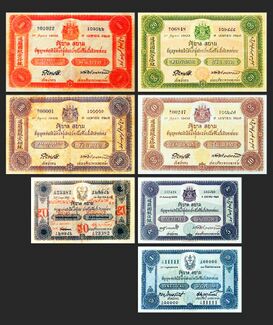
Series 1 was chosen due to the series which precedes this were non-decimal. Series 1 banknotes is the first series to be produced by Thomas De La Rue & Company Limited. In 1900, Charles James Rivett Carnac, a Royal Treasury Ministry advisor proposed that the Siamese Baht followed the issuances of banknotes followed the British standard. The banknote department was established quickly thereafter. The main characteristic of this series was that the notes are onesided and multilingual, containing Chinese, Malay (in Jawi script), and Latin script.[47] It was also the last series to use the term "tical" to refer to the Thai Baht, and the largest in term of size of circulated notes.
| 1th series banknotes | |||||||
|---|---|---|---|---|---|---|---|
| Value | Dimensions | Main colour | Description | Date of issue | |||
| Obverse | Reverse | ||||||
| 1 tical | 165 × 105 mm | Cyan | none | blank | 1918-1925 | ||
| 5 ticals | 165 × 105 mm | Grey | none | blank | 1902-1925 | ||
| 10 ticals | 205 × 126 mm | Brown | none | blank | 1902-1925 | ||
| 20 ticals | 205 × 126 mm | Green | none | blank | 1902-1925 | ||
| 50 ticals | 165 × 105 mm | Grey | none | blank | 1918-1925 | ||
| 100 ticals | 205 × 126 mm | Grey | none | blank | 1903-1928 | ||
| 1000 ticals | 205 × 126 mm | Red | none | blank | 1902-1928 | ||
Before 1902 Pre Decimalization Era
The characteristic of the banknotes of this era is that there were no series issued at the same time, rather they are issued sporadically and have multiple banks producing their own banknotes.
1851-1868 Rama 4 Era Banknotes
1868-1902 Rama 5 Era Banknotes
Royal Tresury Banknotes
| Image | Value | Date of Issue |
|---|---|---|

|
1 Att | 1874 |
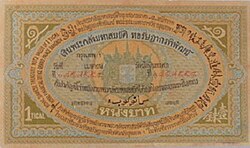
|
1 Tical | 1892 |
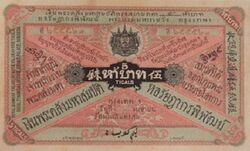
|
5 Tical | |
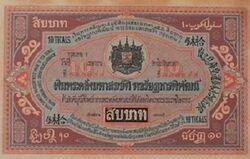
|
10 Tical | |

|
40 Tical | |

|
80 Tical | |
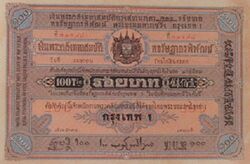
|
100 Tical | |

|
400 Tical | |

|
800 Tical |
HSBC Banknotes
| Image | Value | Date of Issue |
|---|---|---|

|
1 Att | 1889 |
| 1 Tical | ||
| 5 Tical | ||
| 10 Tical | ||
| 40 Tical | ||
| 80 Tical | ||
| 100 Tical | ||
| 400 Tical |
The Chartered Bank of India Australia & China Banknotes
| Image | Value | Date of Issue |
|---|---|---|

|
5 Tical | 1984 |
| 10 Tical | ||
| 40 Tical | ||
| 80 Tical | ||
| 100 Tical | ||
| 400 Tical |
Banque de L'Indo-Chine Banknotes
| Image | Value | Date of Issue |
|---|---|---|

|
5 Tical | 1986 |
| 20 Tical | ||
| 80 Tical | ||
| 100 Tical |
Money and unit of mass
Ngoen (เงิน) is Thai for "silver" as well as the general term for money, reflecting the fact that the baht (or tical) is foremost a unit of weight for precious metals and gemstones. One baht = 15.244 grams.[48] Since the standard purity of Thai gold is 96.5 percent, the actual gold content of one baht by weight is 15.244 × 0.965 = 14.71046 grams; equivalent to about 0.473 troy ounces. 15.244 grams is used for bullion; in the case of jewellery, one baht should be more than 15.16 grams.
Exchange rates


The Bank of Thailand adopted a series of exchange controls on 19 December 2006, which resulted in a significant divergence between offshore and onshore exchange rates, with spreads of up to 10 percent between the two markets. Controls were broadly lifted on 3 March 2008 and there is now no significant difference between offshore and onshore exchange rates.[49]
| Year | USD/THB average exchange rate |
|---|---|
| 1999 | 41.34 |
| 2000 | 40.24 |
| 2001 | 40.26 |
| 2002 | 37.92 |
| 2003 | 32.34 |
| 2004 | 32.99 |
| 2005 | 34.34 |
| 2006 | 31.73 |
| 2007 | 30.48 |
| 2008 | 31.07 |
| 2009 | 30.71 |
| 2010 | 32.48 |
| 2011 | 34.25 |
| 2012 | 35.28 |
| 2013 | 33.91 |
| 2014 | 32.48 |
| 2015 | 34.25 |
| 2016 | 35.30 |
| 2017 | 33.94 |
| 2018 | 32.31 |
| 2019 | 31.05 |
| 2020 | 31.30 |
(Source 1999–2013: usd.fx-exchange.com)
(Source 2014–2020: Bank of Thailand) [5]
See also
- Economy of Thailand
- Stock Exchange of Thailand
References
- ↑ [1] RMB Tracker February 2019
- ↑ "Thailand Commemorative Bullet Coins (112)". https://coincoin.com/I112.htm.
- ↑ "The History of Siamese Money". 2010-06-16. http://www.chiangmai-chiangrai.com/siamese_money.html.
- ↑ "Error: no
|title=specified when using {{Cite web}}" (in th). http://www1.mod.go.th/heritage/nation/krasab/index1.htm. - ↑ "Error: no
|title=specified when using {{Cite web}}" (in th). Royal Thai Mint. http://www.royalthaimint.net/ewtadmin/ewt/mint_web/ewt_news.php?nid=46&filename=index. - ↑ "Error: no
|title=specified when using {{Cite web}}" (in th). 27 March 2019. https://www.silpa-mag.com/history/article_29937. - ↑ "Error: no
|title=specified when using {{Cite web}}" (in th). https://dl.parliament.go.th/handle/lirt/237846.[yes|permanent dead link|dead link}}] - ↑ "The Currency Before and During the War by Prince Vivadhanajaya 21 July BE 2488 (1945)" (in en). https://vajirayana.org/%E0%B8%A7%E0%B8%B4%E0%B8%A7%E0%B8%B1%E0%B8%92%E0%B8%99%E0%B9%84%E0%B8%8A%E0%B8%A2%E0%B8%B2%E0%B8%99%E0%B8%B8%E0%B8%AA%E0%B8%A3%E0%B8%93%E0%B9%8C/%E0%B8%A3%E0%B8%B0%E0%B8%9A%E0%B8%9A%E0%B9%80%E0%B8%87%E0%B8%B4%E0%B8%99%E0%B8%95%E0%B8%A3%E0%B8%B2/currency-and-during-war.
- ↑ (in th)เศรษฐสาร 11 (7 (July)). 1997. http://www.econ.tu.ac.th/oldweb/doc/article/fulltext/81.pdf. Retrieved 28 May 2012.
- ↑ "Error: no
|title=specified when using {{Cite web}}" (in th). http://info.gotomanager.com/news/details.aspx?id=9460. - ↑ de Campos, J. J. (1941). "The Origin of the Tical". Journal of the Siam Society (Siam Heritage Trust) 33.2c. http://www.siamese-heritage.org/jsspdf/1941/JSS_033_2c_Campos_OriginOfTical.pdf. Retrieved June 23, 2013. "From the earliest times in Southern Burma, the weight adopted were not the Chinese liang or tael or its variants, but the Indian bahur and the viss, the latter being divided into 100 ticals. It is this Burmese tical, which was and continues to be in Burma the designation of a definite weight of uncoined silver or its compound, that throws light on the problem of the Thai tical.".
- ↑ "Banknotes, Series 1". 23 February 2012. http://www.bot.or.th/English/Banknotes/HistoryANdSeriesOfBanknotes/Pages/Banknote_Series01.aspx. "each denomination had many types which were printed by Thomas De La Rue & Company Limited, England."
- ↑ "Banknotes, Series 2". 22 November 2020. http://www.bot.or.th/English/Banknotes/HistoryANdSeriesOfBanknotes/Pages/Banknote_Series02.aspx.
- ↑ "Error: no
|title=specified when using {{Cite web}}" (in th). Matichon. http://www.matichon.co.th/mtc-flv-window.php?newsid=1323259839. - ↑ Lekhakum, Nawarat (2009) (in th). เบี้ย บาท กษาปณ์แบงค์ [Cowrie, Baht, Coins, and Bank] โดย นวรัตน์ เลขะกุล. สำนักพิมพ์สารคดี [Sarakhadee Press].
- ↑ 16.0 16.1 The Treasury Department (January 3, 2020). "ราคาประเมินมูลค่าเงินตราโบราณ". https://www.treasury.go.th/th/coin-valuation/.
- ↑ "1835 Rama III unadopted design copper coin "Lotus - MuangThai"". http://phila09-04.eurseree.com/cgi-bin/info/agora.cgi?cart_id=5286534.107769*KJ66o8&p_id=1196&xm=on&ppinc=search2.
- ↑ "Error: no
|title=specified when using {{Cite web}}" (in th). http://www.royalthaimint.net/ewtadmin/ewt/mint_web/ewt_news.php?nid=46&filename=index. - ↑ "Current coins – Royal Thai Mint". http://www.royalthaimint.net/ewtadmin/ewt/mint_web/ewt_news.php?nid=784&filename=index.
- ↑ Gibbs, William T. (Feb 11, 2002). "Thai bahts causing euro problems - 10-baht coins work in place of 2-euro coins in machines". Coin World. Amos Press. http://coinworld.com/news/021802/news-5.asp.
- ↑ http://www.bangkokpost.com/business/economics/32096/20-baht-coins-may-substitute-banknotes.[|permanent dead link|dead link}}]
- ↑ "Banknotes, Series 1". Bank of Thailand. Feb 26, 2012. http://www.bot.or.th/English/Banknotes/HistoryANdSeriesOfBanknotes/Pages/Banknote_Series01.aspx. "The design was printed only on one side; so the note was called 'Uniface banknote'. There were 7 denominations...."
- ↑ "Banknotes, Series 2". Bank of Thailand. Feb 26, 2012. http://www.bot.or.th/English/Banknotes/HistoryANdSeriesOfBanknotes/Pages/Banknote_Series02.aspx. "on the back side was the picture of the Royal Ploughing Ceremony. This type of banknote was called "Ploughing Ceremony Note"."
- ↑ Duncan Stearn (27 June – 3 July 2003). "Rise of state-sponsored militarism and socialism". Pattaya Mail (Pattaya: Pattaya Mail Publishing Co) XI (26). http://www.pattayamail.com/517/columns.shtml#hd6. Retrieved 18 Feb 2012. ""Does Japan dominate Siam?" I asked a leading Englishman in Bangkok. He laughed quietly: "Have you any Siamese money?" he asked. I drew out a five-ticul note (about 2 dollars 50c). "Read what is printed at the foot of the note", he commanded. I read, "Thomas de la Rue and Co., London". With calm confidence he said: "As long as the word 'London' stands on that Siamese bill, it is not Japan but another little island which will have the larger say in the Kingdom of Siam."".
- ↑ "New banknotes coming in December". The Nation. 2010-07-28. http://www.nationmultimedia.com/home/2010/07/28/national/New-banknotes-coming-in-December-30134701.html. "new Thai banknote will circulate in December 2010"
- ↑ "Thailand to issue new note family in December 2010". http://banknotenews.com/files/07dfceb6e55bf92b146e10839d677bdc-1202.php.
- ↑ "The Introduction of Two Commemorative Banknotes on the Auspicious Occasions of Her Majesty the Queen's 80th Birthday Anniversary 12 August 2012 and His Royal Highness Crown Prince Maha Vajiralongkorn's 5th Cycle Birthday Anniversary". 3 July 2012. http://www.bot.or.th/Thai/PressAndSpeeches/Press/News2555/n3655e.pdf.
- ↑ Commemorative Banknote in Remembrance of His Majesty King Bhumibol Adulyadej Bank of Thailand (www.bot.or.th). Retrieved on 2017-07-21.
- ↑ The Bank of Thailand Launches New Series of Thai Banknotes (Series 17) Bank of Thailand (https://www.bot.or.th ). Retrieved on 2018-03-09.
- ↑ Wararat, service manager. "Reproduction of Thai banknotes". Bank of Thailand. http://www.bot.or.th/English/Banknotes/Banknote%20service/Pages/Banknote_for_AD.aspx. "In Thailand, the Bank of Thailand (BOT) has the sole right to design, produce, issue, circulate and manage Thai banknotes. The reproduction of Thai banknotes is protected by the Copyright Act B.E. 2537 Ch.1 Pt.5 §27 (2) communication to public."
- ↑ 31.0 31.1 31.2 "Circulating Banknotes". Bank of Thailand. http://www.bot.or.th/English/Banknotes/HistoryANdSeriesOfBanknotes/Pages/Current_Series_of_Banknotes.aspx.
- ↑ "Series of Banknotes at Bank of Thailand's official website". https://www.bot.or.th/English/Banknotes/HistoryAndSeriesOfBanknotes/Pages/20_16.aspx.
- ↑ "ธปท.เปิดตัวแบงก์ 50 ใหม่ เริ่มใช้ 18 ม.ค.-ปลอมยาก!". ASTV Manager Daily. http://www.thanonline.com/index.php?option=com_content&view=article&id=176215:-20-&catid=143:2011-01-26-05-35-57&Itemid=597.
- ↑ "50_16". https://www.bot.or.th/English/Banknotes/HistoryAndSeriesOfBanknotes/Pages/50_16.aspx.
- ↑ "ธปท.ออกใช้ธนบัตรชนิดราคา 20บาท แบบใหม่". Than Setthakij. http://www.manager.co.th/Home/ViewNews.aspx?NewsID=9550000004990.
- ↑ "100_16". https://www.bot.or.th/English/Banknotes/HistoryAndSeriesOfBanknotes/Pages/100_16.aspx.
- ↑ Press release announcing the issuance of the Series 16 100 baht banknote Bank of Thailand (www.bot.or.th). Retrieved on 2015-02-24.
- ↑ "500_16". https://www.bot.or.th/English/Banknotes/HistoryAndSeriesOfBanknotes/Pages/500_16.aspx.
- ↑ Press release announcing the issuance of the Series 16 500 baht banknote Bank of Thailand (www.bot.or.th). Retrieved on 2014-05-08.
- ↑ "1000 Baht Series 16". https://www.bot.or.th/English/Banknotes/HistoryAndSeriesOfBanknotes/Pages/1000_16.aspx.
- ↑ Press release announcing the issuance of the Series 16 1,000 baht banknote Bank of Thailand (www.boh.or.th). Retrieved on 2015-08-18.
- ↑ "The Bank of Thailand Launches New Series of Thai Banknotes (Series 17), BOT Press Release No. 17/2018" (in en). https://www.bot.or.th/Thai/PressandSpeeches/Press/News2561/n1761e.pdf.
- ↑ "Series 9" (in en). https://www.bot.or.th/en/our-roles/banknotes/History-and-Series-of-Banknote-And-Commemorative/banknotes-series/banknote-series9.html.
- ↑ "ธนบัตรแบบ10" (in en). https://www.bot.or.th/en/our-roles/banknotes/History-and-Series-of-Banknote-And-Commemorative/banknotes-series/banknote-series10.html.
- ↑ "ธนบัตรแบบ11" (in en). https://www.bot.or.th/en/our-roles/banknotes/History-and-Series-of-Banknote-And-Commemorative/banknotes-series/banknote-series11.html.
- ↑ "ธนบัตรแบบ13" (in en). https://www.bot.or.th/en/our-roles/banknotes/History-and-Series-of-Banknote-And-Commemorative/banknotes-series/banknote-series13.html.
- ↑ "1st Series Thai Banknotes". http://www.siambanknote.com/banknote-appraisal/1st-series-thaibanknote-price.htm.
- ↑ "A sure bet or fool's gold?", Bangkok Post 2010-01-10[|permanent dead link|dead link}}]
- ↑ "UPDATE 1-Onshore and offshore Thai baht converge, c.bank seen". Reuters. 3 March 2008. http://in.reuters.com/article/idINSP20869920080303.
- Sources
- Cecil Carter eds. [clarification needed], The Kingdom of Siam 1904, reprint by the Siam Society 1988, ISBN:974-8298-13-2, chapter X Currency and Banking
External links
- (in Thai) Compare exchange rates of the Thai Baht from many bank in Thailand (archived)
- (in English, German, and French) The banknotes of Thailand (archived)
 |


